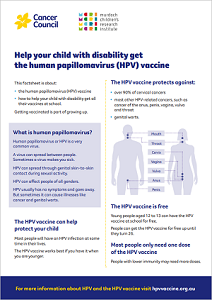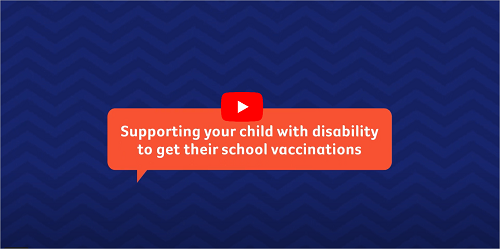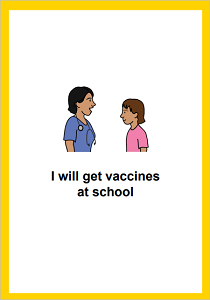Background
The human papillomavirus (HPV) vaccine used in Australia called Gardasil®9 protects against nine types of HPV that cause almost all cases of cervical cancer, other HPV-related cancers and genital warts.
The introduction of the HPV vaccine to the National Immunisation Program in 2007 has contributed to significantly reducing the number of HPV infections, genital warts and pre-cancers of the cervix in Australia.
In fact, the HPV vaccination program, combined the the National Cervical Screening Program, has put Australia on track to be one of the first places to eliminate cervical cancer as a public health issue by as early as 2035. 1
Under the National Immunisation Program, the HPV vaccine is free to all Australians aged 12 to 25. Children aged 12 to 13 are offered the vaccine through school-based programs.
Among Australian school students, approximately 1 in 10 of those aged 5 to 18 years have some level of disability, as defined by The Disability Act of 1992. 2
Vaccinations for anyone can be stressful and there can be unique barriers for people with disability, with young people with disability in Victoria recording lower HPV vaccination coverage than their typically developing peers. 3
People with disability may also face other barriers to cervical screening and access to treatment, making HPV vaccination especially important to provide crucial protection against cervical cancer and other HPV related cancers.
To help improve the HPV vaccination experience for children with disability, with funding provided by the Victorian Department of Health, Cancer Council Victoria in consultation with Murdoch Children’s Research Institute and Scope Australia, has developed new resources to support parents and carers prepare their children.
How you can help
Whether you work in a school setting, or organisation that works with families living with disability, these resources are designed to help increase HPV vaccination rates for children with disability and make the vaccination process easier for families and children.
Below you will also find text and images that you can share on your website, in newsletters and on your social media to promote these resources.
Resources
You can download them for free below or order hard copy versions by emailing hpvvaccine@cancervic.org.au
Fact sheet
This fact sheet for parents and carers of children with disability provides a brief overview of HPV, the HPV vaccine and how to support their child through the experience.

Animation
This animation for parents and carers of children with disability provides a more in-depth explanation of HPV, the HPV vaccine and other vaccines your child can receive at school and the steps you can take to improve your child’s vaccination experience.

Social story
This social story can support parents and carers to plan for vaccination day at school. The social story is customisable in parts to help make a plan that suits their child.

Download the Preparing for school vaccinations social story.
Article for newsletter/websites
Help improve HPV vaccination rates for young people with disability
Having the HPV vaccine is an important way to protect against HPV-related diseases such as cervical cancer, other HPV-related cancers and genital warts.
Although vaccinations are important, they can be stressful, and there are sometimes unique barriers for people with disability. In Victoria, HPV vaccination coverage for children with disability is lower than the rest of their peers, putting them at greater risk of HPV-related cancers and diseases.
With funding provided by the Victorian Department of Health, Cancer Council Victoria in consultation with Murdoch Children’s Research Institute and Scope Australia, has developed new resources to improve the vaccination experience for young people with disability and their parents/carers, including a fact sheet, animation and social story.
For more information and to access these resources, visit Cancer Council’s HPV vaccine website: hpvvaccine.org.au/disability
Social media
Sample post 1
Are you a parent or carer of a child with disability?
Cancer Council Victoria, in consultation with Murdoch Children’s Research Institute and Scope Australia, has developed new resources to support parents and carers to improve the HPV vaccination experience for their child with disability.
The HPV vaccine protects against HPV-related diseases including cervical cancer, other HPV-related cancers and genital warts and is free for all Australians aged 12 to 25.
Find out more and download the resources at hpvvaccine.org.au/disability
Sample post 2
The HPV vaccine is free for all Australians aged 12 to 25, to protect against HPV-related diseases including cervical cancer, other HPV-related cancers and genital warts in the future.
Vaccinations can be stressful and sometimes there are unique barriers for people with disability.
To help improve the HPV vaccination experience for children with disability, Cancer Council Victoria, with funding from the Victorian Department of Health, in consultation Murdoch Children’s Research Institute and Scope Australia, has developed new resources to support parents and carers to prepare their child.
Find out more and access the resources at hpvvaccine.org.au/disability
If you have any questions about the resources or content on this page, please email hpvvaccine@cancervic.org.au
References
- Hall MT, Simms KT, Lew JB, Smith MA, Brotherton JML, Saville M 2019. The projected timeframe until cervical cancer elimination in Australia: A modelling study. The Lancet Public Health:4(1);E19-E27.
- Australian Institute of Health and Welfare (2022) People with disability in Australia 2022, catalogue number DIS 72, AIHW, Australian Government. aihw-dis-72-people-with-disability-in-australia-2022
- O’Neil J, Newall F, Antolovich G, Lima S & Danchin M ‘Vaccination in people with disability: a review’ Human Vaccines & Immunotherapeuticals, 2020; 16(1): 7–15, doi: 10.1080/21645515.2019.1640556